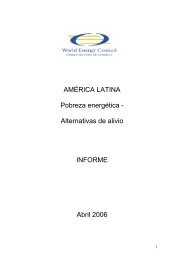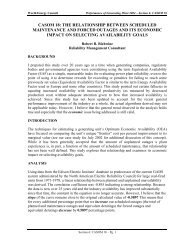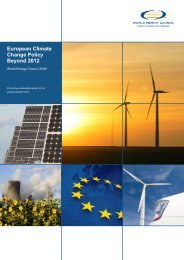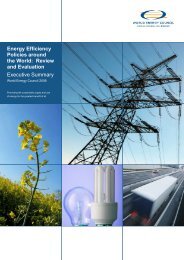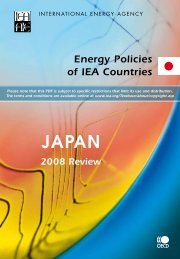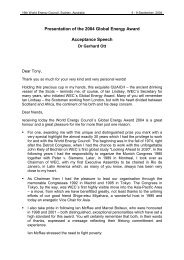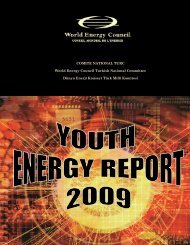Deciding the Future: Energy Policy Scenarios to 2050
Deciding the Future: Energy Policy Scenarios to 2050
Deciding the Future: Energy Policy Scenarios to 2050
Create successful ePaper yourself
Turn your PDF publications into a flip-book with our unique Google optimized e-Paper software.
82<br />
<strong>Deciding</strong> <strong>the</strong> <strong>Future</strong>: <strong>Energy</strong> <strong>Policy</strong> <strong>Scenarios</strong> <strong>to</strong> <strong>2050</strong> World <strong>Energy</strong> Council 2007 Recommendations<br />
A new level of wise energy policy, energy regulation, and energy<br />
investment is required now and in <strong>the</strong> next few years if we are <strong>to</strong><br />
achieve energy sustainability in <strong>the</strong> 2035-<strong>2050</strong> timeframe.<br />
obvious that a new level of wise energy policy,<br />
energy regulation, and energy investment is<br />
required now and in <strong>the</strong> next few years if we are<br />
<strong>to</strong> achieve energy sustainability in <strong>the</strong> 2035-<br />
<strong>2050</strong> timeframe.<br />
There is a critical need for unprecedented levels<br />
of cooperation and integration in both <strong>the</strong> private<br />
and public sec<strong>to</strong>rs if GDP growth is <strong>to</strong> continue,<br />
sustainable energy supply and end-use systems<br />
are <strong>to</strong> be achieved for <strong>the</strong> benefit of mankind,<br />
and anthropogenic climate change is <strong>to</strong> be<br />
mitigated. Public–private partnerships must<br />
become even more important than <strong>the</strong>y are<br />
<strong>to</strong>day.<br />
These levels of cooperation are also essential if<br />
global energy intensity (E/GDP) is <strong>to</strong> continue <strong>to</strong><br />
decline, but it will take some time (at least <strong>to</strong> <strong>the</strong><br />
very end of <strong>the</strong> period) for overall energy<br />
demand <strong>to</strong> stabilise. The goal of having more<br />
ra<strong>the</strong>r than fewer energy primary sources and<br />
conversion options available is in fact achievable<br />
in <strong>the</strong> shorter term. The result is that <strong>the</strong> energy<br />
mix will continue <strong>to</strong> diversify.<br />
Perhaps surprisingly, careful government<br />
regulation is desired by <strong>the</strong> private sec<strong>to</strong>r <strong>to</strong><br />
ensure attractiveness and fair competition for<br />
energy industries and services, and rules of<br />
trade across national borders and globally are<br />
also supported by <strong>the</strong> private sec<strong>to</strong>r. However,<br />
consistent long-term signals also need <strong>to</strong> be<br />
sent, lest investments focus only on <strong>the</strong> short <strong>to</strong><br />
medium-term.<br />
While <strong>the</strong> level of public awareness has<br />
increased as <strong>the</strong> security of energy supplies and<br />
climate change attract attention, it needs <strong>to</strong> be<br />
markedly increased even fur<strong>the</strong>r. People cannot<br />
make informed decisions without adequate<br />
information offered in plain language. Concerted<br />
public–private efforts need <strong>to</strong> be made <strong>to</strong><br />
increase <strong>the</strong> public’s awareness of <strong>the</strong> issues<br />
involved with energy security and sustainability.<br />
In terms of differences between regions, Europe<br />
is generally more optimistic about its ability <strong>to</strong><br />
decrease energy intensity than o<strong>the</strong>rs, but it<br />
worries about <strong>the</strong> security of supply. Africa<br />
believes it will take longer <strong>to</strong> decrease energy<br />
intensity (already <strong>the</strong> highest) and expand its<br />
energy mix than o<strong>the</strong>r regions, owing <strong>to</strong> its<br />
position of using significantly less energy per<br />
capita than o<strong>the</strong>rs <strong>to</strong>day. Asia and Africa both<br />
see continued use of coal until late in <strong>the</strong> time<br />
period. Africa and Latin America see serious<br />
dilemmas surrounding Acceptability in <strong>the</strong> face<br />
of low levels of Accessibility. North America<br />
sees Acceptability as <strong>the</strong> largest issue in this<br />
region with <strong>the</strong> exception of Mexico, where<br />
Accessibility is still a major problem.<br />
<strong>Policy</strong> actions <strong>to</strong> deal with this situation are:<br />
Strong and consistent long-term<br />
signals about energy goals and<br />
policies. These signals should be<br />
designed on two principles: that all<br />
energy options are on <strong>the</strong> table, <strong>the</strong><br />
choice depending on individual country<br />
resources and regional market<br />
integration, and that it is possible <strong>to</strong><br />
achieve a doubling of global energy<br />
supplies and continued economic growth<br />
in harmony with a low carbon society.



